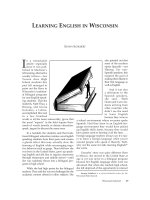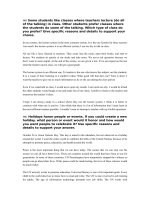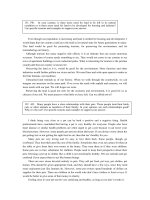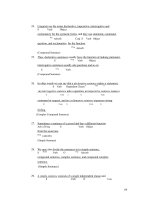Tài liệu Learning English in Wisconsin doc
Bạn đang xem bản rút gọn của tài liệu. Xem và tải ngay bản đầy đủ của tài liệu tại đây (146.68 KB, 5 trang )
Wisconsin Interest 29
I
n a remarkable
article—especially
since it was pub-
lished in Madison’s
left-leaning alternative
weekly Isthmus—two
Verona Area High
School students this
past fall managed to
point out the flaws in
Wisconsin’s tradition-
al bilingual programs
for non-English speak-
ing students. That the
students, Npib Thao, a
Hmong, and Gloria
Gonzales, a Latina,
accomplished this task
in a few hundred
words is all the more noteworthy, given that
the usual “experts” in the field require thou-
sands of words (mostly in obtuse education-
speak jargon) to discuss the same issue.
In a nutshell, the students said that tradi-
tional bilingual education isolates non-English
speaking students from their peers and creates
a ghetto effect that may actually slow the
learning of English while encouraging nega-
tive behavior such as gangs. Thao told how she
was born in the United States, grew up speak-
ing English and did fine in regular classrooms
through elementary and middle school—until
she was suddenly thrust into a bilingual pro-
gram in high school.
While she had high praise for her bilingual
teachers, Thao said she was not challenged by the
academic content offered in other subjects. She
also pointed out that
most of the teachers
spoke Spanish—not
Hmong. For non-
Spanish speakers, this
negated the goal of
making them fluent in
their first language as
well as English.
And it was also
a detriment to the
Spanish speakers,
she said. “Both
Gloria and I saw stu-
dents arriving from
other countries who
didn’t see the need
to learn English
because they were in
a school environment where everyone spoke
Spanish. Had they been in an English-lan-
guage environment they would have picked
up English skills faster, because they would
have gotten used to hearing it all the time. . . .
Foreign language teachers always say it’s easi-
er to learn a foreign language when you’re
around people who speak it fluently. Well,
why not the same for kids learning English?”
she wrote.
Gonzales’ story was quite different: Born
in Mexico, she moved to the United State at
age 4, yet was never in a bilingual program
because her English language skills were too
advanced. But when she reached high school,
she felt deprived of the opportunity to interact
L
EARNING
E
NGLISH IN
W
ISCONSIN
S
UNNY
S
CHUBERT
Sunny Schubert is a retired editorial writer for the
Wisconsin State Jounral.
with other Hispanic students since most of
them were in bilingual classes that segregated
them from the English-speaking majority.
If the other Hispanic students were in the
regular classes, I would get to know them
better. At the same time, if they were sur-
rounded by English speakers, they would
learn English faster, too.
Out of the mouths of babes!
So why doesn’t Wisconsin, which likes to
brag so much about the high quality of its
schools—and where taxpayers like to com-
plain so much about the high cost of education
—decide to end its failed flirtation with bilin-
gual education and adopt more successful
teaching strategies, such as English immersion
or English as a Second Language?
To understand this issue, one must first
understand the differences in nomenclature
defining the various ways non-English speak-
ing students are taught what should be our
national language. (State and federal laws refer
to these students as “LEPS,” which stands for
“limited English proficiency students,” while
educators prefer to call them “ELLs,” for
“English Language Learners”.)
In English immersion, non-English speak-
ing students generally get about a year of
intensive academic study in their native
tongue along with English instruction before
being “mainstreamed” into the general
English-speaking student body. Critics like call
this method “submersion” or “sink or swim”
and say it produces students who are not flu-
ent in either English or their native tongue.
Proponents note that immersion is the method
most favored by the military, the business
community and wealthy travelers who want to
acquire a language the most quickly.
In English as a Second Language (ESL),
students are taught the bulk of their academic
subjects in English, while receiving intensive
English instruction and special help in their
native language—assuming the school has
someone on staff who speaks it. While the bulk
of non-English speaking students in Wisconsin
are either Latino (51%) or Hmong (31%), the
Department of Public Instruction reports that
at least 80 languages are spoken by one or
more Wisconsin students. ESL is the model
most frequently found in Europe, where most
countries have a far greater immigrant popula-
tion than does the United States.
Then there is bilingual education, which is
mandated in all Wisconsin schools with a cer-
tain percentage of ESL students. Its purpose is
distinctly different from immersion and ESL
programs, which aim at producing English-
proficient students as quickly as possible.
Bilingual education, as its name implies, aims
at producing students who are proficient in
two languages: English and their native
tongue. Bob Peterson, a proponent of bilingual
education and a fifth-grade teacher at
Milwaukee’s La Escuela Fratney, notes that
there are a plethora of bilingual teaching meth-
ods and programs. They include two-way pro-
grams (also called “maintenance” or “enrich-
ment”) such as those employed at La Escuela
Fratney and Madison’s Nostra Mundo, where
mixed populations of Spanish- and English-
speaking students are simultaneously taught
in both languages. Other bilingual models are
transitional (all subjects taught in the native
tongue except English, the most predominant
program) and restoration programs (typical for
Native American schools where a language is
in danger of dying out). Other terms used
seemingly interchangeably are developmental
bilingual programs, dual language programs,
bilingual immersion, two-way immersion, and
sheltered or structured immersion.
These definitions, however, are all quite
squishy and ever-evolving. For example, after
California famously adopted mandatory
immersion programs instead of bilingual pro-
grams, both critics (happily) and proponents
(dolefully) noted that in many school districts,
only the name changed, while instructional
methods remained quite the same.
And regardless of the teaching method,
the goal of all programs is the same: Producing
fluent English-speakers.
Those critics of bilingual education (by any
name) who argue that “My grandparents
Winter 200630
immigrated here a hundred years ago and they
learned English without any help” are flat-out
wrong. During the 1800s, public schools where
languages other than English were spoken
flourished throughout the United States, wher-
ever a particular immigrant group set down
roots. Wisconsin had German-, Polish- and
Welsh-speaking schools; Michigan its Finnish-
and Dutch-speaking schools. On the West
Coast, there were Spanish, Chinese, and
Japanese schools.
Also, as Peterson and others have noted,
many first-generation immigrants never did
bother to learn English. For one thing, much like
the Spanish-speaking students encountered by
Thao and Gonzales, they
had no need for English
because they were isolated
in ethnic communities,
surrounded by fellow
immigrants who didn’t
speak English either.
Furthermore, they didn’t
need to know English to
get a fairly good-paying
job: Bricklaying is brick-
laying, whether in English
or German. For the large
percentage that went into
farming, the cows and
horses didn’t care what
language they spoke.
This is not true anymore. We have entered
the global economy, where English is widely
regarded as the language of the realm and
high-tech skills are needed to enter the eco-
nomic mainstream. It is in immigrants’ best
interest to acquire English as quickly as possi-
ble. And it is in the best interests of English-
speaking Americans to help them, for the sake
of national unity as well as economic expedi-
ency: The faster they learn English, the less
money taxpayers will have to pay to teach
them English. Immersion programs take as lit-
tle as a year, while traditional bilingual pro-
grams average four to seven years.
But minus a giant shove forward by the
people and their duly-elected political repre-
sentatives, the bilingual education establish-
ment has little incentive to move quickly.
While school administrators may bemoan the
money spent on bilingual education that might
otherwise be spent on math or science or for-
eign language for English-speaking students,
bilingual teachers have a vested interest in
maintaining large populations of limited-
English-proficient students—especially since
most districts pay a premium for bilingual
teachers.
This was the situation in California in
1997, where after a spirited debate, voters
approved an initiative mandating English
immersion. The initiative forces were infused
with cash by Silicon
Valley entrepreneur Ron
Unz and backed by
famed Los Angeles edu-
cator Jaime Escalante of
“Stand and Deliver”
movie fame.
Escalante, for those
who don’t remember the
film starring Edward
James Olmos, came to the
United States at age 32
with no English. He
worked in menial jobs
while learning the lan-
guage and earning a
teaching degree, then pro-
ceeded to teach poor, inner-city Hispanic stu-
dents difficult math concepts that too many
teachers had assumed they were incapable of
learning.
Wrote Escalante in support of the English
immersion proposition:
It seems a real tragedy that in many cases
our public schools are not teaching English
to 5- or 6-year-old immigrant children,
who are at an age when they could so easi-
ly learn the language. . .
I also believe that the bilingual education
programs found in many California
schools are a very poor substitute for
English language instruction. At Garfield
H.S. in East LA, where I began my success-
Bilingual teachers have
a vested interest in
maintaining large
populations of limited-
English-proficient
students
Wisconsin Interest 31
ful Calculus Advanced Placement pro-
gram, I also worked hard to eliminate most
of the school's bilingual education classes,
which I felt were holding students back in
their academic studies. I feel that my
efforts against these misguided programs
were an important contribution to the suc-
cess of my Garfield students.
Although some California politicians seem
to support bilingual education for various
reasons, my own experiences as a teacher
leads me to believe that these programs are
a negative factor for most immigrant chil-
dren, who instead should be taught
English while they are young.
Leading the fight against the initiative
were Hispanic activists bent on maintaining
the Hispanic culture. But arrayed against them
were an overwhelming percentage of Hispanic
parents, who believed their children were not
learning English fast enough. The proposition
was approved by 61% of the voters, including
80% of Hispanic voters. Arizona shortly there-
after also approved an English-immersion ini-
tiative. But when similar proposals in
Colorado and Massachusetts failed, the immer-
sion movement seemed to run out of steam.
Admittedly, results from immersion
instruction in California and Arizona have not
been as glowing as proponents proclaim.
Certain California districts did show dramatic
gains in test scores among English Language
Learners; however, California had simultane-
ously reduced class sizes across the board.
Once test scores were adjusted for “test infla-
tion,” the gains were much smaller although
still significant—enough to convert some
bilingual teachers who had opposed the initia-
tive. Boston University’s Christine H. Rossell,
evaluating the program for the Public Policy
Institute of California, wrote in 2002:
Teachers in the structured immersion class-
rooms were universally pleased at the suc-
cess of the program. Former Spanish bilin-
gual teachers were pleased at how rapid
was their students’ progress in English in
the sheltered English immersion and how
proud their students were to be learning
English.
However, says Rossell, teachers in pro-
grams that had merely changed in name from
“bilingual” to “immersion” without altering
teaching methods were less pleased, and
“Former Chinese bilingual teachers. . . contin-
ued to do what they had always done—teach
children to read and write in English in a shel-
tered environment.”
(The number of California students
enrolled in bilingual programs also dropped
dramatically; however, this was more a matter
of definition than an actual gain in proficiency,
much as Wisconsin Works, the Badger State’s
bold welfare reform program, dramatically cut
the number of welfare recipients without much
of a simultaneous reduction in poverty.)
Results were similar in Arizona, where the
State School Superintendent Tom Horne
reported in 2004 that students in structured
English immersion classes outperformed bilin-
gual education students by up to four months
in grades 2-4, by six months in grade 5, and by
more than a year in 6th grade and above. The
results held true in all areas tested: reading,
language, and math. Horne told the Heartland
Institute, “Hopefully there are no additional
students subjected to these educationally infe-
rior bilingual programs.”
But there are in Wisconsin, where bilin-
gual programs are considered the “best prac-
tice.”
Educators point to a state statute enacted
during the 1970s that requires schools to pro-
vide “bilingual” programs and services to non-
English speaking students. However, at that
time the word “bilingual” had not come to
define the specific programs it does today.
Bilingual education does not come cheaply.
The number of students classified as limited-
English proficient has risen from 10,879 in the
1982-83 school year to 35,602 in 2003-04. For the
next biennium, the Legislature has appropriated
almost $9.9 million to aid the 49 school districts
that have enough non-English speakers to qual-
ify for help. Those districts enroll almost 23,000
students in bilingual programs, while another
13,000-plus limited-English students are scat-
Winter 200632
tered throughout 189 districts that don’t qualify
for aid. (Ironically, those students in schools
that don’t get aid may be learning English
faster—through ESL or immersion programs
prompted exclusively by a lack of resources—
than students in schools that receive state aid
for bilingual programs.) Districts that do get
state aid will be reimbursed for about 11% of
the cost of providing bilingual programs. With
the exception of districts that also receive feder-
al aid, that means local property taxpayers are
stuck with 87% of the tab for bilingual educa-
tion in aided districts, and 100% of the cost in
non-aided districts.
These taxpayers are as entitled to get the
best value for their money as non-English
speaking students are to the best teaching
methods.
Now is the perfect time for Wisconsin to
determine which method—traditional bilin-
gual programs or structured immersion pro-
grams—works best. As part of the federal “No
Child Left Behind” education act, DPI and the
UW-Madison’s Wisconsin Center for
Education Research will begin evaluating—for
the first time in almost 30 years!—the effec-
tiveness of its bilingual programs. What better
time to offer the immersion method to a hand-
ful of districts or schools and see whether it
measures up to, or exceeds, traditional bilin-
gual methods in helping students speedily
acquire English proficiency?
Wisconsin has a chance to settle, perhaps
once and for all, the debate over language
acquisition methods without the messes
caused by California’s and Arizona’s citizen
initiatives. But given the fondness for the sta-
tus quo exhibited by DPI officials and the edu-
cation establishment, including teachers’
unions, it will take legislative will to launch
the experiment. Lawmakers from both parties
must unite and do what’s right for property
taxpayers as well as the growing thousands of
non-English proficient students who call
Wisconsin home.
Wisconsin Interest 33









